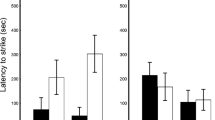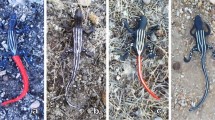Abstract
Caudal autotomy is an effective antipredator strategy widespread among lizards. The shed tail thrashes vigorously for long periods to distract the predator and facilitate the lizard’s escape. This movement is maintained by energy supplied by the anaerobic conversion of glycogen into lactate. It has been suggested that lactate accumulation serves as an index for the vigor of tail thrashing. We made three predictions: (1) tail loss frequency should be higher under heavier predation regime, (2) the duration of postautotomy tail movement should be extended in populations under heavy predation pressure as an adaptation to the higher risk and the increased need for defense, and (3) as result, lactate in these tail tissues should be concentrated at higher levels. To eliminate the impact of phylogeny and environmental factors on the interpretation of our result, we focused exclusively on one species, the Balearic lizard (Podarcis lilfordi). We studied three populations under different predation pressure but sharing the same climatic conditions. We found no differences among the studied populations either in postautotomy duration of tail movement or in levels of final lactate accumulation while autotomy frequency was higher where predation pressure was more intense. Τail loss effectiveness is directly influenced by the level of predation, while secondary features of the trait appear to remain independent from the impact of environment.

Similar content being viewed by others
References
Adamopoulou C, Pafilis P, Valakos E (1999) Diet composition of Podarcis milensis, Podarcis gaigeae and Podarcis erhardii (Sauria: Lacertidae) during summer. Bonn Zool Beitr 48:275–282
Arnold EN (1984) Evolutionary aspects of tail shedding in lizards and their relatives. J Nat Hist 18:127–169
Arnold EN (1988) Caudal autotomy as a defense. In: Gans C, Huey RB (eds) Biology of the reptilia 16, ecology B: defense and life history. Alan R Liss, New York, pp 235–273
Bellairs DA, Bryant SV (1985) Autotomy and regeneration in reptiles. In: Gans BC, Billet F (eds) Biology of the reptilia 15, development. Wiley, New York, pp 301–410
Brown RP, Pérez-Mellado V (1994) Ecological energetics and food acquisition in dense Menorcan islet populations of the lizard Podarcis lilfordi. Funct Ecol 8:427–434
Caloi L, Kotsakis T, Palombo MR (1988) La fauna a vertebrati terrestri del Pleistocene delle isole del Mediterraneo. Bull Ecol 19:131–151
Chapple DG, Swain R (2002) Effect of caudal autotomy on locomotor performance in a viviparous skink, Niveoscincus metallicus. Funct Ecol 16:817–825
Chondropoulos BP, Maragou P, Valakos ED (1993) Food consumption of Podarcis taurica ionica (Lehrs, 1902) in the Ionian islands (Greece). In: Valakos ED, Boehme W, Pérez -Mellado V, Maragou P (eds) Lacertids of the Mediterranean Region: a biological approach. Hellenic Zoological Society, Athens, pp 173–182
Clark DR (1971) The strategy of tail autotomy in the ground skink Lygosoma laterale. J Exp Zool 176:295–302
Congdom JD, Vitt LJ, King WW (1974) Geckos: adaptive significance and energetics of tail autotomy. Science 184:1379–1380
Cooper WE, Pérez-Mellado V, Vitt LJ (2004) Ease and effectiveness of costly autotomy vary with predation intensity among lizard populations. J Zool 262:243–255
Dial BE, Fitzpatrick LC (1981) The energetic costs of tail autotomy to reproduction in the lizard Coleonyx brevis (Sauria: Gekkonidae). Oecologia 51:310–317
Dial BE, Fitzpatrick LC (1983) Lizard tail autotomy: function and energetics of postautotomy tail movement in Scinella lateralis. Science 219:391–393
Fox SF, McCoy JK (2000) The effect of tail loss on survival, growth, reproduction, and sex ratio of offspring in the lizard Uta stransburiana in the field. Oecologia 122:327–334
Fox SF, Rostker MA (1982) Social cost of tail loss in Uta strasburiana. Science 218:692–693
Gleeson TT (1996) Post-exercise lactate metabolism: a comparative review of sites, pathways, and regulation. Annu Rev Physiol 58:565–581
Goldstein DL, Pinshow B (2006) Taking physiology to the field: using physiological approaches to answer questions about animals in their environment. Physiol Biochem Zool 79:237–241
Hohorst HJ (1965) L- (+) lactate determination with lactate dehydrogonase and DNP. In: Bergmeyer HU (ed) Methods of enzymatic analysis. Academic, New York, pp 266–270
Huey RB (1987) Phylogeny, history and the comparative method. In: Feder ME, Bennett AF, Burggren WW, Huey RB (eds) New directions in ecological physiology. Cambridge University Press, Cambridge, pp 76–101
Kotsakis T (1981) Le lucertole (Lacertidae, Squamata) del Pliocene, Pleistocene e Olocene delle Baleari. Boll Soc Hist Nat Balears 25:135–150
Martin J, Avery RA (1998) Effects of tail loss on the movement patterns of the lizard, Psammodromus algirus. Funct Ecol 12:794–802
Martin J, Salvador A (1992) Tail loss consequences on habitat use by the Iberian rock-lizard, Lacerta monticola. Oikos 65:328–333
Meyer V, Preest MR, Lochetto SM (2002) Physiology of original and regenerated lizard tails. Herpetologica 58:75–86
Naya DE, Bozinovic F (2006) The role of ecological interactions on the physiological flexibility of lizards. Funct Ecol 20:601–608
Pafilis P, Valakos ED, Foufopoulos J (2005) Comparative postautotomy tail activity in six Mediterranean lacertid species. Physiol Biochem Zool 78:828–838
Pérez-Mellado V (1989) Estudio ecologico de la lagartija balear Podarcis lilfordi (Gunther, 1874) en Menorca. Rev Menorca 53:455–511
Pérez-Mellado V (1998) Podarcis lilfordi (Günther, 1874). In: Ramos MA et al (ed) Fauna Ibérica 10, Reptiles. Museo Nacional de Ciencias Naturales, Madrid, pp 272–282
Pérez-Mellado V, Corti C, LoCascio P (1997) Tail autotomy and extinction in Mediterranean lizards. A preliminary study of continental and insular populations. J Zool 243:553–541
Pérez-Mellado V, Perera A, Cortázar G (2003) La Lagartija balear, Podarcis lilfordi (Günther, 1884) de l’ Illa d’ en Colom, Parc Natural de s’ Albufera des Grau (Menorca). Situación actual y estado de conservación. Bul Cien Esp Prot Bal 1:23–34
Pianka E (2001) The role of phylogenetics in evolutionary ecology. In: Lymberakis P, Valakos E, Pafilis P, Mylonas M (eds) Herpetologia Candiana. S.E.H, Iraklion, pp 1–20
Pough FH, Andrews RM (1985) Use of anaerobic metabolism by free-ranging lizards. Physiol Zool 58:205–213
Salvador A (1986) Podarcis lilfordi (Gunther, 1874)—Balearen—Eidechse. In: Boehme W (ed) Handbuch der Reptilien und Amphibien Europas 2, Echsen 3. Aula, Wiesbaden, pp 83–110
Schoener TW (1979) Inferring the properties of predation and other injury-producing agents from injury frequencies. Ecology 60:1110–1115
Seifter U, Dayton S, Novic B, Muntwyler E (1950) The estimation of glycogen with anthrone reagent. Arch Biochem 24:191–200
Turner FB, Medica PA, Jennrich RI, Maza BG (1982) Frequencies of broken tails among Uta stansburiana in southern Nevada and a test of the predation hypothesis. Copeia 1982:835–840
Vitt LJ, Cooper WE (1986) Tail loss, tail color, and predator escape in Eumeces (Lacertilia: Scincidae): age-specific differences in costs and benefits. Can J Zool 64:583–592
Vitt LJ, Congdom JD, Dickson NA (1977) Adaptive strategies and energetics of tail autotomy in lizards. Ecology 58:326–337
Acknowledgements
We would like to express our deep gratitude for the linguistic revision to Johannes Foufopoulos. All experiments comply with Spanish and Greek legislation for the Protection of Wildlife and Environment. All animals were released after the experimental procedure, and none was killed.
Author information
Authors and Affiliations
Corresponding author
Rights and permissions
About this article
Cite this article
Pafilis, P., Pérez-Mellado, V. & Valakos, E. Postautotomy tail activity in the Balearic lizard, Podarcis lilfordi . Naturwissenschaften 95, 217–221 (2008). https://doi.org/10.1007/s00114-007-0320-5
Received:
Revised:
Accepted:
Published:
Issue Date:
DOI: https://doi.org/10.1007/s00114-007-0320-5




